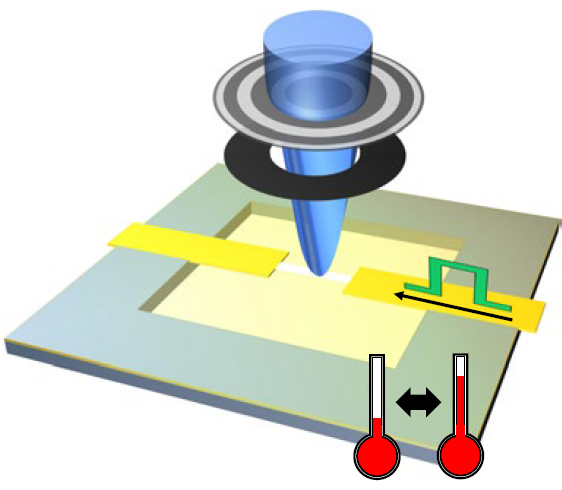Skyrmions like it hot: Spin structures are controllable even at high temperatures

The researchers observed the magnetic skyrmions in an x-ray microscope on a sample of adjustable temperature. ill./©: Kai Litzius
The joint research project of Johannes Gutenberg University Mainz (JGU) and the Massachusetts Institute of Technology (MIT) that had previously demonstrated the use of new spin structures for future magnetic storage devices has yet achieved another milestone.
The international team is working on structures that could serve as magnetic shift registers, so called racetrack memory devices. This type of storage promises low access times, high information density, and low energy consumption.
The new insights published in Nature Electronics shed light on the effects of temperature on the dynamics of skyrmions. According to the researchers' findings, skyrmions move more efficiently at higher temperatures and their trajectories only depend on the speed of the skyrmions. This makes device design significantly easier.
Skyrmions could serve as data bits for racetrack memory devices in the future
The teams at JGU and MIT observed billionfold reproducible motion of skyrmions, a new topologically stabilized spin structure that is a promising candidate to be used as data bits in the racetrack device.
The latest experiments were carried out in thin films of magnetic material that stabilize skyrmions at and above room temperature, which is a feature that is required for any application. As it turned out, there currently are limits to the speed of a skyrmion caused by its deformations that will need to be overcome, possibly in antiferromagnetic materials.
“This is a great moment as we have worked for a long time to get this study completed. Now that we know that skyrmions can be moved billionfold and at high temperatures that are typical for the insides of a computer, we can focus on tackling the high-speed regime and get the device from its experimental state to being superior to existing storage technology,” said Dr. Kai Litzius, lead author of the article.
Litzius conducted this work at Johannes Gutenberg University Mainz, combined with a research stay at MIT. After finishing his PhD, he moved to the United States to work at MIT as a postdoctoral associate.
Cooperation with leading international partners as the cornerstone of successful research
“I am very happy to see the next step taken for using skyrmions as magnetic bits in novel devices. The international collaboration with leading partner universities is crucial to enable such work and such collaborations, and exchanges of people are a cornerstone of our graduate education programs,” emphasized Professor Mathias Kläui, corresponding author of the paper.
“With funding from the German Academic Exchange Service, the Collaborative Research Center CRC/TRR 173 Spin+X, and the Graduate Programs MAINZ – Materials Science in Mainz and MPGC – Max Planck Graduate Center with Johannes Gutenberg University Mainz, we foster these collaborations and exchanges that can be the stepping stone for the next career step.”
Funding for the MAINZ Graduate School was approved in the 2007 German Excellence Initiative. In the second round in 2012, MAINZ was awarded further funding for another five years. One of its core research fields was spintronics, a field of research in which collaboration with leading international partners plays an important role. In 2019, the MAINZ Graduate School merged with the Max Planck Graduate Center with Johannes Gutenberg University Mainz (MPGC).
Image:
https://download.uni-mainz.de/presse/08_physik_komet_skyrmion_temperatur.jpg
The researchers observed the magnetic skyrmions in an x-ray microscope on a sample of adjustable temperature.
ill./©: Kai Litzius
Related links:
https://www.klaeui-lab.physik.uni-mainz.de/ – Kläui Lab at the JGU Institute of Physics
https://www.mpgc-mainz.de/ – Max Planck Graduate Center with Johannes Gutenberg University Mainz (MPGC)
https://www.mainz.uni-mainz.de/ – Graduate School of Excellence Materials Science in Mainz (MAINZ)
Read more:
https://www.uni-mainz.de/presse/aktuell/8323_ENG_HTML.php – press release “The power of randomization: Magnetic skyrmions for novel computer technology” (7 May 2019)
https://www.uni-mainz.de/presse/20661_ENG_HTML.php – press release “Investigations of the skyrmion Hall effect reveal surprising results” (27 Dec. 2016)
https://www.uni-mainz.de/presse/20165_ENG_HTML.php – press release “International research team achieves controlled movement of skyrmions” (7 March 2016)
https://www.uni-mainz.de/presse/18027_ENG_HTML.php – press release “Physicists observe motion of tiny magnetic whirls” (3 Feb. 2015)
Professor Dr. Mathias Kläui
Condensed Matter Physics
Institute of Physics
Johannes Gutenberg University Mainz
55099 Mainz, GERMANY
phone +49 6131 39-23633
e-mail: klaeui@uni-mainz.de
https://www.klaeui-lab.physik.uni-mainz.de/homepage-prof-dr-mathias-klaeui/
K. Litzius et al., The role of temperature and drive current in skyrmion dynamics, Nature Electronics 3, 30-36, 24 January 2020,
DOI:10.1038/s41928-019-0359-2
https://www.nature.com/articles/s41928-019-0359-2
Media Contact
All latest news from the category: Information Technology
Here you can find a summary of innovations in the fields of information and data processing and up-to-date developments on IT equipment and hardware.
This area covers topics such as IT services, IT architectures, IT management and telecommunications.
Newest articles

First-of-its-kind study uses remote sensing to monitor plastic debris in rivers and lakes
Remote sensing creates a cost-effective solution to monitoring plastic pollution. A first-of-its-kind study from researchers at the University of Minnesota Twin Cities shows how remote sensing can help monitor and…

Laser-based artificial neuron mimics nerve cell functions at lightning speed
With a processing speed a billion times faster than nature, chip-based laser neuron could help advance AI tasks such as pattern recognition and sequence prediction. Researchers have developed a laser-based…

Optimising the processing of plastic waste
Just one look in the yellow bin reveals a colourful jumble of different types of plastic. However, the purer and more uniform plastic waste is, the easier it is to…



